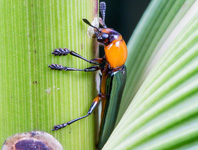Abstract
Atopophlebia pacis sp. nov. and Atopophlebia caldasi sp. nov. are newly described based on material from Colombia, Putumayo and Caldas, respectively. Both species are known from nymphs and alate stages, male imago for A. pacis, male subimago, female imago and eggs for A. caldasi. This is the first description of eggs of the genus. The following characteristics are useful for distinguishing the males of the new species: A. pacis sp. nov., 1) eyes meeting on meson of head; 2) fore wings hyaline, veins yellow (Fig. 2); 3) fore tibia completely tinged with black; 4) abdominal segments yellowish, terga VIII with conspicuous triangular anterolateral black mark (Fig. 1); 5) apical projection of penis lobe short; A. caldasi sp. nov., 1) eyes meeting on meson of head; 2) fore tibia completely tinged with black; 3) abdominal segments orange, posterior margin of all terga tinged with black, black bands broader on terga V to VIII. Egg of A. caldasi is characterized by presenting a prismatic shape with longitudinal chorionic depressions at the sides and concave polar regions. An updated key for male adults of Atopophlebia is presented.
References
Domínguez, E. (1995) Cladistic analysis of the Ulmeritus-Ulmeritoides group (Ephemeroptera, Leptophlebiidae), with descriptions of five new species of Ulmeritoides. Journal of the New York Entomological Society, 103 (1), 15–38.
Domínguez, E. & Cuezzo, M.G. (2002) Ephemeroptera egg chorion characters: a test of their importance in assessing phylogenetic relationships. Journal of Morphology, 253 (2), 148–165.
https://doi.org/10.1002/jmor.1117Domínguez, E. (2009) Overview and phylogenetic relationships of the two-winged genera of South American Leptophlebiidae (Ephemeroptera). Aquatic Insects, 31 (Supplement 1), 63–71.
https://doi.org/10.1080/01650420802518077Domínguez, E., Molineri, C., Pescador, M.L., Hubbard, M.D. & Nieto, C. (2006) Ephemeroptera of South America. Aquatic Biodiversity of Latin America. Vol. 2. Pensoft, Sofia-Moscow, 646 pp.
Domínguez, E. & Molineri, C. (1996) A new species of Atopophlebia (Ephemeroptera: Leptophlebiidae: Atalophlebiinae) from Bolivia and Argentina. Aquatic Insects, 18 (1), 55–59.
https://doi.org/10.1080/01650429609361603Emmerich, D.E. (2007) Two new species of Tricorythodes Ulmer (Ephemeroptera: Leptohyphidae) from Colombia. Zootaxa, 1561, 63–68.
Flowers, R.W. & Domínguez, E. (1991) Preliminary cladistics of the Hermanella complex (Ephemeroptera: Leptophlebiidae: Atalophlebiinae). In: Alba-Tercedor, J. & Sanchez-Ortega, A. (Eds.), Overview and Strategies of Ephemeroptera and Plecoptera. Sandhill Crane Press, Gainesville, pp. 49–62.
Flowers, R.W. (1980) Atopophlebia fortunensis, a new genus and species from Panama (Leptophlebiidae: Ephemeroptera). Florida Entomologist, 63, 162–165.
https://doi.org/10.2307/3494670Flowers, R.W. (1987) New species and life stages of Atopophlebia (Ephemeroptera: Leptophlebiidae: Atalophlebiinae). Aquatic Insects, 9 (4), 203–209.
https://doi.org/10.1080/01650428709361297Flowers, R.W. (2012) A new species of Atopophlebia Flowers (Ephemeroptera: Leptophlebiidae) from western Ecuador with ecological and biogeographic notes on the genus. Zootaxa, 3478, 11–18.
Gutiérrez, C. & Reinoso-Flórez, G. (2010) Géneros de ninfas del orden Ephemeroptera (Insecta) del departamento del Tolima, Colombia: listado preliminar. Biota Colombiana, 11 (1–2), 23–32.
Kluge, N.J. (2007) A new taxon Hermanellonota, or subtribe Hermanellini subtr.n. (Ephemeroptera: Leptophlebiidae: Hagenulini), with description of three new species from Peruvian Amazonia. Russian Entomological Journal, 16 (4), 385–400.
Koss, R.W. & Edmunds, G.F. (1974) Ephemeroptera eggs and their contribution to phylogenetic studies of the order. Zoological Journal of the Linnean Society, 55 (4), 267–349.
https://doi.org/10.1111/j.1096-3642.1974.tb01648.xMorrone, J.J. (2014) Cladistic biogeography of the Neotropical region: identifying the main events in the diversification of the terrestrial biota. Cladistics, 30 (2014), 202–214.
https://doi.org/10.1111/cla.12039Mosquera, S., Zúñiga, M.C. & Alba-Tercedor, J. (2001) Atopophlebia fortunensis Flowers (Ephemeroptera: Leptophlebiidae) and Caenis chamie Alba-Tercedor and Mosquera (Ephemeroptera: Caenidae). Notes on Their Biology and Ecology. In: Domínguez, E. (Ed.), Trends in Research in Ephemeroptera and Plecoptera. Springer, Boston, MA, pp. 157–160.
Ramírez, J.J., Roldán, P.G. & Yepes, G.A. (2004) Altitudinal variation of the numerical structure and biodiversity of the taxocenosis of Ephemeroptera in the South, North and Central regions of the Department of Antioquia, Colombia. Acta Limnologica Brasiliensia, 16 (4), 329–339.
Souto, P.M., Da Silva, E.R., Nessimian, J.L. & Gonçalves, I.C. (2016) Two new species of Ulmeritoides Traver (Ephemeroptera: Leptophlebiidae) from Southeastern Brazil. Zootaxa, 4078 (1), 127–136.
https://doi.org/10.11646/zootaxa.4078.1.11Zuñiga De Cardoso, M.C., Rojas De Hernández, A.M. & Mosquera De Aguilar, S. (1997) Biological aspects of Ephemeroptera in rivers of Southwestern Colombia (South America). In: Landolt, P. & Sartori, M. (Eds.), Ephemeroptera & Plecoptera. Biology-Ecology-Systematics. Mauron + Tinguely & Lachat, SA. Fribourg, pp. 261–268.

